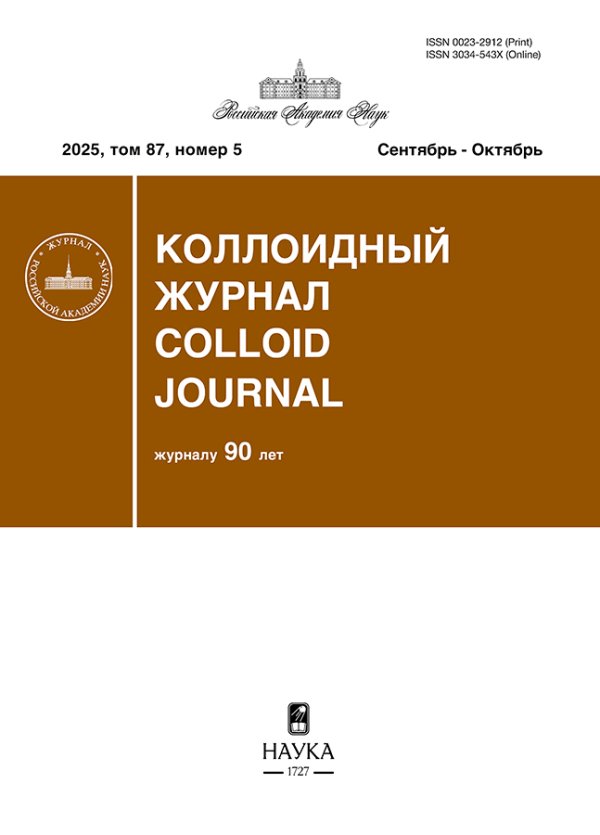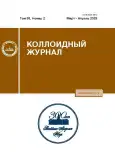CONTACT ANGLE HYSTERESIS ON SOLID CRYSTALLINE SURFACES
- Authors: ESIPOVA N.E.1, ITSKOV S.V.1, SOBOLEV V.D.1
-
Affiliations:
- Frumkin Institute of Physical Chemistry and Electrochemistry, Russian Academy of Sciences, Moscow, Russia
- Issue: Vol 85, No 2 (2023)
- Pages: 158-166
- Section: Articles
- Submitted: 16.10.2023
- Published: 01.03.2023
- URL: https://journal-vniispk.ru/0023-2912/article/view/137204
- DOI: https://doi.org/10.31857/S0023291222600602
- EDN: https://elibrary.ru/UTLOHF
- ID: 137204
Cite item
Full Text
Abstract
The article presents the results of experimental studying the hysteresis of water contact angles at crystalline surfaces. Receding and advancing contact angles and their hysteresis at hydrophilic and hydrophobic substrates with different surface structures (silica, mica, and calcite) have been studied under the action of an external pressure applied to the three-phase contact line of a sessile air bubble. Hysteresis of the contact angles has been observed on hydrophobized samples of silica and mica. The anchoring of the three-phase contact line (pinning) facilitates a change in the contact angles under the applied external pressure. When the three-phase contact line moves along the hydrophilic surfaces of silica and mica no marked changes in the advancing and receding contact angles are observed, and the hysteresis is actually absent. The stable pinning observed on the polished surface of a calcite crystal brought in contact with water leads to the appearance of contact angle hysteresis and hydrophilization of the calcite surface, with the hydrophilization being related to structural displacements in the crystal lattice.
About the authors
N. E. ESIPOVA
Frumkin Institute of Physical Chemistry and Electrochemistry, Russian Academy of Sciences, Moscow, Russia
Email: nesipova@mail.ru
Россия, 119071, Москва, Ленинский просп. 31, корп. 4
S. V. ITSKOV
Frumkin Institute of Physical Chemistry and Electrochemistry, Russian Academy of Sciences, Moscow, Russia
Email: nesipova@mail.ru
Россия, 119071, Москва, Ленинский просп. 31, корп. 4
V. D. SOBOLEV
Frumkin Institute of Physical Chemistry and Electrochemistry, Russian Academy of Sciences, Moscow, Russia
Author for correspondence.
Email: nesipova@mail.ru
Россия, 119071, Москва, Ленинский просп. 31, корп. 4
References
- de Gennes P.G. Wetting: static and dynamics // Reviews of Modern Physics. 1985. V. 57. № 3. Part 1. P. 827–863.
- Eral H.B., Mannetje D.J.C.M., Oh J.M. Contact angle hysteresis: a review of fundamentals and applications // Colloid Polym. Sci. 2012. V. 291. P. 247–260.
- Tadmor R., Bahadur P., Leh A., N’guessan H.E., Jaini R., Dang L. Measurement of lateral adhesion forces at the interface between a liquid drop and a substrate // Phys. Rev. Lett. 2009. V. 103. № 26. P. 266101.
- Pierce E., Carmona F.J., Amirfazli A. Understanding of sliding and contact angle results in tilted plate experiments // Colloid Surf. A: Physicochemical and Engineering Aspects. 2008. V. 323. № 1–3. P. 73–82.
- Bourges-Monnier C., Shanahan M.E.R. Influence of evaporation on contact angle // Langmuir. 1995. V. 11. № 7. P. 2820–2829.
- Erbil H.Y., McHale G., Rowan S.M., Newton M.I. Determination of the receding contact angle of sessile drops on polymer surfaces by evaporation // Langmuir. 1999. V. 15. № 21. P. 7378–7385.
- Bormashenko E., Bormashenko Y., Whyman G., Pogreb R., Musin A., Jager R., Barkay Z. Contact angle hysteresis on polymer substrates established with various experimental techniques, its interpretation, and quantitative characterization // Langmuir. 2008. V. 24. № 8. P. 4020–4025.
- Andrieu C., Sykes C., Brochard F. Average spreading parameter on heterogeneous surfaces // Langmuir. 1994. V. 10. № 7. P. 2077–2080.
- Wang Y., Bhushan B. Liquid microdroplet sliding on hydrophobic surfaces in the presence of an electric field // Langmuir. 2009. V. 25. № 16. P. 9208–9218.
- Bonn D., Eggers J., Indekeu J., Meunier J., Rolley E. Wetting and spreading // Rev. Mod. Phys. 2009. V. 81. № 2. P. 739.
- Rayleigh L. On the capillary phenomena of jets // Proceedings of the Royal Society of London. 1879. V. 29. P. 71–97.
- Starov V.M., Velarde M.G. Surface forces and wetting phenomena // J. Phys. Condens. Matter. 2009. V. 21. № 46. P. 464121.
- Kuchin I., Starov V. Hysteresis of contact angle of sessile droplets on smooth homogeneous solid substrates via disjoining/conjoining pressure // Langmuir. 2015. V. 31. P. 5345–5352.
- Kuchin I., Starov V. Hysteresis of the contact angle of a meniscus inside a capillary with smooth, homogeneous solid walls // Langmuir. 2016. V. 32. P. 5333−5340.
- Дерягин Б.В., Чураев Н.В., Муллер В.М. Поверхностные силы. М.: Наука, 1985. 398 с.
- Chibowski E., Jurak M. Comparison of contact angle hysteresis of different probe liquids on the same solid surface // Colloid. Polym. Sci. 2013. V. 291. № 2. P. 391–399.
- Fernández-Toledano J.-C., Rigaut C., Mastrangeli M., De Coninck J. Controlling the pinning time of a receding contact line under forced wetting conditions // J. Colloid Interface Sci. 2020. V. 565. P. 449–457.
- Liu Y., Wang J., Zhang X., Wang W. Contact line pinning and the relationship between nanobubbles and substrates // J. Chem. Phys. 2014. V. 140. P. 054705.
- Liu Y., Bernard S., Widmer-Cooper A. Stability of pinned surface nanobubbles against expansion: insights from theory and simulation // J. Chem. Phys. 2020. V. 153. № 2. P. 024704.
- Кучма А.Е., Есипова Н.Е., Михеев А.А., Щёкин А.К., Ицков С.В. Влияние неидеальности раствора в сидячей бинарной капле на динамику ее испарения // Коллоид. журн. 2019. Т. 81. № 6. С. 724–733.
- Русанов А.И., Есипова Н.Е., Соболев В.Д. Температурный пиннинг сидящего пузырька // ДАН. Химия, науки о материалах. 2020. Т. 491. С. 69–72.
- Kusudo H., Omori T., Yamaguchi Y. Extraction of the equilibrium pinning force on a contact line exerted from a wettability boundary of a solid surface through the connection between mechanical and thermodynamic routes // J. Chem. Phys. 2019. V. 151. № 15. P. 154501.
- Сумм Б.Д. Гистерезис смачивания. Соровский образовательный журнал. 1999. № 7. С. 98–102.
- McHale G., Orme B.V., Wells G., Ledesma-Aguilar R. Apparent contact angles on lubricant impregnated surfaces/SLIPS: from superhydrophobicity to electrowetting // Langmuir. 2019. V. 35. P. 4107–4204.
- Есипова Н.Е., Ицков С.В. Кинетика роста воздушных пузырьков на кремниевой подложке в спиртовой и водно-спиртовой средах // Коллоид. журн. 2021. Т. 83. № 4. C. 404–411.
- Kuzina E.A., Emelyanenko K.A., Domantovskii A.G. et al. Preparation of stable superhydrophobic coatings on a paint surface with the use of laser treatment followed by hydrophobizer deposition // Colloid J. 2022. V. 84. P. 445–455.
- Есипова Н.Е., Русанов А.И., Соболев В.Д., Ицков С.В. Влияние гидростатического давления на краевой угол сидящего пузырька // Коллоид. журн. 2019. Т. 81. № 5. С. 1–8.
- Makkonen L. A thermodynamic model of contact angle hysteresis // The Journal of Chemical Physics. 2017. V. 147. P. 064703.
- Quere D. Wetting and Roughness // Annu. Rev. Mater. Res. 2008. V. 38. P. 71–99.
- Сумм Б.Д., Горюнов Ю.В. Физико-химические основы смачивания и растекания. М.: Химия, 1976. 232 с.
- Songen H., Schlegel S.J., Jaques Y.M., Tracey J., Hosseinpour S. et al. Water orientation at the calcite–water interface // J. Phys. Chem. Lett. 2021. V. 12. P. 7605−7611.
- Cooke D.J., Gray R.J., Sand K.K, Stipp S.L.S., Elliott J.A. Interaction of ethanol and water with the {101̅4} surface of calcite // Langmuir. 2010. V. 26. № 18. P. 14520–14529.
- Li H., Vovusha H., Sharma S., Singh N., Schwingenschlog U. Mechanism of wettability alteration of the calcite {1014} surface // Phys. Chem. Chem. Phys. 2020. V. 22. P. 15365.
- Fenter P., Sturchio N.C. Calcite (104)–water interface structure, revisited // Geochimica et Cosmochimica Acta. 2012. V. 97. P. 58–69.
Supplementary files



















